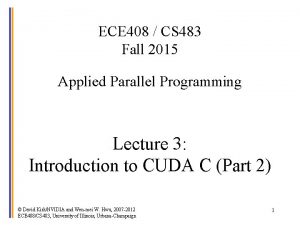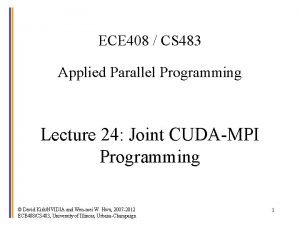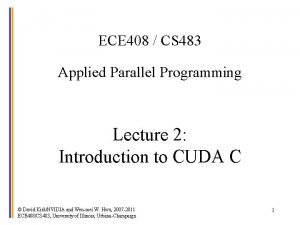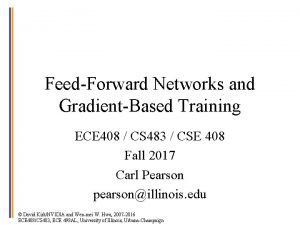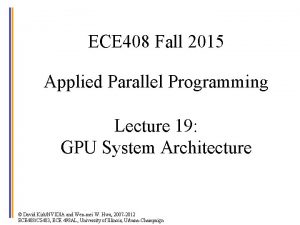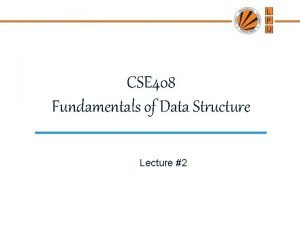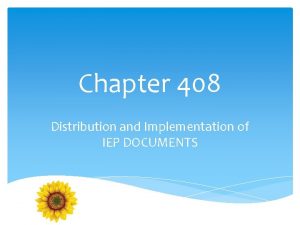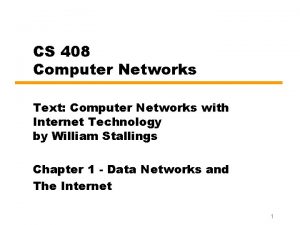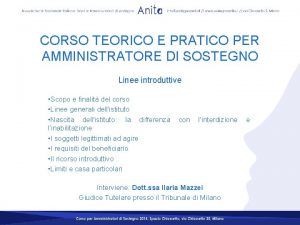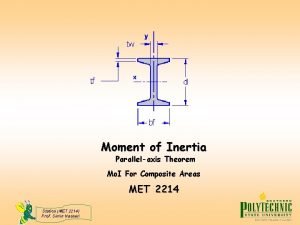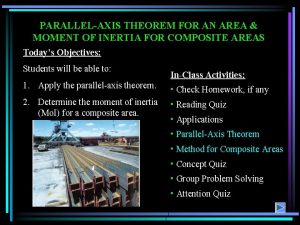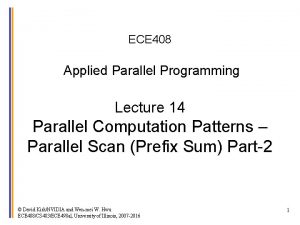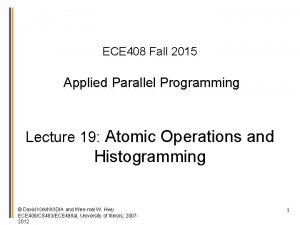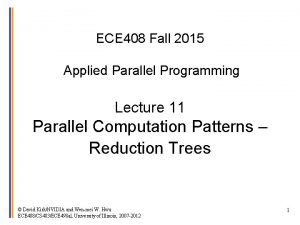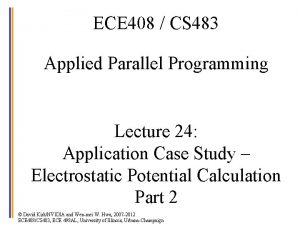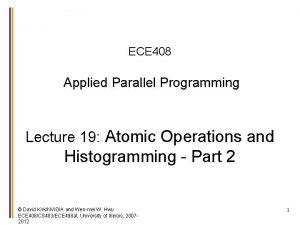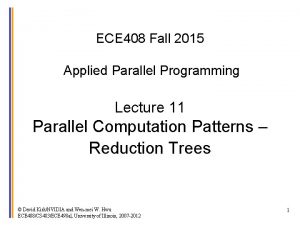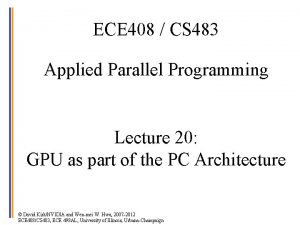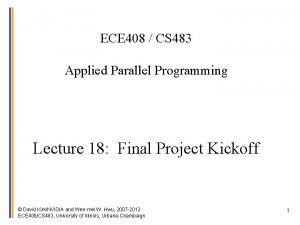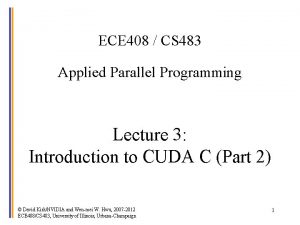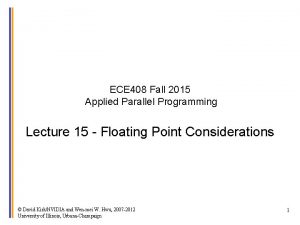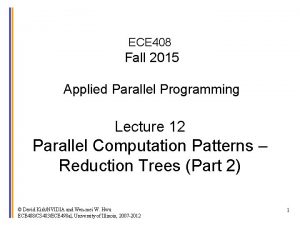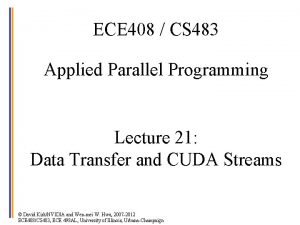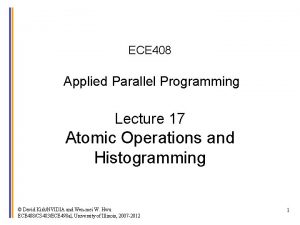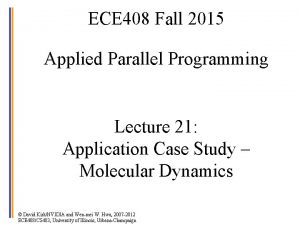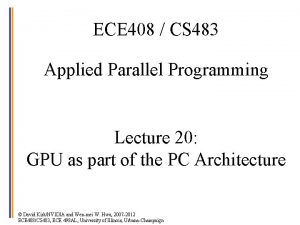ECE 408 Applied Parallel Programming Lecture 12 Parallel















![Parallel Algorithm Overhead __shared__ float partial. Sum[2*BLOCK_SIZE]; unsigned int t = thread. Idx. x; Parallel Algorithm Overhead __shared__ float partial. Sum[2*BLOCK_SIZE]; unsigned int t = thread. Idx. x;](https://slidetodoc.com/presentation_image_h2/078a715b6a4dd34255cc83338cb06657/image-16.jpg)
![Parallel Algorithm Overhead __shared__ float partial. Sum[2*BLOCK_SIZE]; unsigned int t = thread. Idx. x; Parallel Algorithm Overhead __shared__ float partial. Sum[2*BLOCK_SIZE]; unsigned int t = thread. Idx. x;](https://slidetodoc.com/presentation_image_h2/078a715b6a4dd34255cc83338cb06657/image-17.jpg)


- Slides: 19

ECE 408 Applied Parallel Programming Lecture 12 Parallel Computation Patterns – Reduction Trees (Part 2) © David Kirk/NVIDIA and Wen-mei W. Hwu ECE 408/CS 483/ECE 498 al, University of Illinois, 2007 -2012 1

Objective • To understand the performance factors of a reduction kernel – Memory coalescing – Control divergence – Thread utilization • To develop a basic kernel and a more optimized kernel © David Kirk/NVIDIA and Wen-mei W. Hwu ECE 408/CS 483/ECE 498 al, University of Illinois, 2007 -2012 2

A Sum Example Thread 0 Data 3 1 4 2 11 Thread 1 1 7 7 Thread 2 0 4 5 14 Thread 3 1 6 3 9 Active Partial Sum elements 3 25 steps © David Kirk/NVIDIA and Wen-mei W. Hwu ECE 408/CS 483/ECE 498 al, University of Illinois, 2007 -2012 3

Simple Thread Index to Data Mapping • Each thread is responsible of an even-index location of the partial sum vector – One input is the location of responsibility • After each step, half of the threads are no longer needed • In each step, one of the inputs comes from an increasing distance away © David Kirk/NVIDIA and Wen-mei W. Hwu ECE 408/CS 483/ECE 498 al, University of Illinois, 2007 -2012 4

A Simple Thread Block Design • Each thread block takes 2* Block. Dim input elements • Each thread loads 2 elements into shared memory __shared__ float partial. Sum[2*BLOCK_SIZE]; unsigned int t = thread. Idx. x; Unsigned int start = 2*block. Idx. x*block. Dim. x; partial. Sum[t] = input[start + t]; partial. Sum[block. Dim+t] = input[start+ block. Dim. x+t]; © David Kirk/NVIDIA and Wen-mei W. Hwu ECE 408/CS 483/ECE 498 al, University of Illinois, 2007 -2012 5

The Reduction Steps for (unsigned int stride = 1; stride <= block. Dim. x; stride *= 2) { __syncthreads(); if (t % stride == 0) partial. Sum[2*t]+= partial. Sum[2*t+stride]; } Why do we need syncthreads()? © David Kirk/NVIDIA and Wen-mei W. Hwu ECE 408/CS 483/ECE 498 al, University of Illinois, 2007 -2012 6

Barrier Synchronization • __syncthreads() are needed to ensure that all elements of each version of partial sums have been generated before we proceed to the next step • Why do we not need another __syncthread() at the end of the reduction loop? © David Kirk/NVIDIA and Wen-mei W. Hwu ECE 408/CS 483/ECE 498 al, University of Illinois, 2007 -2012 7

Back to the Global Picture • Thread 0 in each thread block write the sum of the thread block in partial. Sum[0] into a vector indexed by the block. Idx. x • There can be a large number of such sums if the original vector is very large – The host code may iterate and launch another kernel • If there are only a small number of sums, the host can simply transfer the data back and add them together. © David Kirk/NVIDIA and Wen-mei W. Hwu ECE 408/CS 483/ECE 498 al, University of Illinois, 2007 -2012 8

Some Observations • In each iteration, two control flow paths will be sequentially traversed for each warp – Threads that perform addition and threads that do not – Threads that do not perform addition still consume execution resources • No more than half of threads will be executing after the first step – All odd-index threads are disabled after first step – After the 5 th step, entire warps in each block will fail the if test, poor resource utilization but no divergence. • This can go on for a while, up to 5 more steps (1024/32=16= 25), where each active warp only has one productive thread until all warps in a block retire – Some warps will still succeed, but with divergence since only one thread will succeed © David Kirk/NVIDIA and Wen-mei W. Hwu ECE 408/CS 483/ECE 498 al, University of Illinois, 2007 -2012 9

Thread Index Usage Matters • In some algorithms, one can shift the index usage to improve the divergence behavior – Commutative and associative operators • Example - given an array of values, “reduce” them to a single value in parallel – Sum reduction: sum of all values in the array – Max reduction: maximum of all values in the array – … © David Kirk/NVIDIA and Wen-mei W. Hwu ECE 408/CS 483/ECE 498 al, University of Illinois, 2007 -2012 10

A Better Strategy • Always compact the partial sums into the first locations in the partial. Sum[] array • Keep the active threads consecutive © David Kirk/NVIDIA and Wen-mei W. Hwu ECE 408/CS 483/ECE 498 al, University of Illinois, 2007 -2012 11

An Example of 16 threads Thread 0 Thread 1 Thread 2 0 1 2 Thread 14 Thread 15 3 … 0+16 © David Kirk/NVIDIA and Wen-mei W. Hwu ECE 408/CS 483/ECE 498 al, University of Illinois, 2007 -2012 13 14 15 16 17 18 19 15+31 12

A Better Reduction Kernel for (unsigned int stride = block. Dim. x; stride > 0; stride /= 2) { __syncthreads(); if (t < stride) partial. Sum[t] += partial. Sum[t+stride]; } © David Kirk/NVIDIA and Wen-mei W. Hwu ECE 408/CS 483/ECE 498 al, University of Illinois, 2007 -2012 13

A Quick Analysis • For a 1024 thread block – No divergence in the first 5 steps – 1024, 512, 256, 128, 64, 32 consecutive threads are active in each step – The final 5 steps will still have divergence © David Kirk/NVIDIA and Wen-mei W. Hwu ECE 408/CS 483/ECE 498 al, University of Illinois, 2007 -2012 14

A Story about an Old Engineer • Listen to the recording. © David Kirk/NVIDIA and Wen-mei W. Hwu ECE 408/CS 483/ECE 498 al, University of Illinois, 2007 -2012 15
![Parallel Algorithm Overhead shared float partial Sum2BLOCKSIZE unsigned int t thread Idx x Parallel Algorithm Overhead __shared__ float partial. Sum[2*BLOCK_SIZE]; unsigned int t = thread. Idx. x;](https://slidetodoc.com/presentation_image_h2/078a715b6a4dd34255cc83338cb06657/image-16.jpg)
Parallel Algorithm Overhead __shared__ float partial. Sum[2*BLOCK_SIZE]; unsigned int t = thread. Idx. x; unsigned int start = 2*block. Idx. x*block. Dim. x; partial. Sum[t] = input[start + t]; partial. Sum[block. Dim+t] = input[start+ block. Dim. x+t]; for (unsigned int stride = block. Dim. x/2; stride >= 1; stride >>= 1) { __syncthreads(); if (t < stride) partial. Sum[t] += partial. Sum[t+stride]; } © David Kirk/NVIDIA and Wen-mei W. Hwu ECE 408/CS 483/ECE 498 al, University of Illinois, 2007 -2012 16
![Parallel Algorithm Overhead shared float partial Sum2BLOCKSIZE unsigned int t thread Idx x Parallel Algorithm Overhead __shared__ float partial. Sum[2*BLOCK_SIZE]; unsigned int t = thread. Idx. x;](https://slidetodoc.com/presentation_image_h2/078a715b6a4dd34255cc83338cb06657/image-17.jpg)
Parallel Algorithm Overhead __shared__ float partial. Sum[2*BLOCK_SIZE]; unsigned int t = thread. Idx. x; unsigned int start = 2*block. Idx. x*block. Dim. x; partial. Sum[t] = input[start + t]; partial. Sum[block. Dim+t] = input[start+ block. Dim. x+t]; for (unsigned int stride = block. Dim. x/2; stride >= 1; stride >>= 1) { __syncthreads(); if (t < stride) partial. Sum[t] += partial. Sum[t+stride]; } © David Kirk/NVIDIA and Wen-mei W. Hwu ECE 408/CS 483/ECE 498 al, University of Illinois, 2007 -2012 17

Parallel Execution Overhead 3 1 7 0 4 1 6 3 + + Although the number of “operations” is N, each “operation involves much more complex address calculation and intermediate 9 4 7 5 result manipulation. + hardware, it If the parallel code+ is executed on a single-thread would be significantly slower than the code based on the original sequential algorithm. 7 6 + © David Kirk/NVIDIA and Wen-mei W. Hwu ECE 408/CS 483/ECE 498 al, University of Illinois, 2007 -2012 7 18

ANY MORE QUESTIONS? READ SECTION 6. 1 © David Kirk/NVIDIA and Wen-mei W. Hwu ECE 408/CS 483/ECE 498 al, University of Illinois, 2007 -2012 19
 Cs483 uiuc
Cs483 uiuc Cs 483
Cs 483 Ece 408
Ece 408 Ece 408
Ece 408 Ece408
Ece408 01:640:244 lecture notes - lecture 15: plat, idah, farad
01:640:244 lecture notes - lecture 15: plat, idah, farad Cse408
Cse408 408(b)(2) checklist
408(b)(2) checklist Usace section 408
Usace section 408 Chapter 408 pdf
Chapter 408 pdf Cs 408 sabancı
Cs 408 sabancı Pub 408
Pub 408 Art 408 cc
Art 408 cc Map study in highway engineering
Map study in highway engineering C programming lecture
C programming lecture Moment of inertia addition
Moment of inertia addition Area moment of inertia parallel axis theorem
Area moment of inertia parallel axis theorem Perbedaan linear programming dan integer programming
Perbedaan linear programming dan integer programming Greedy vs dynamic
Greedy vs dynamic System programming definition
System programming definition
